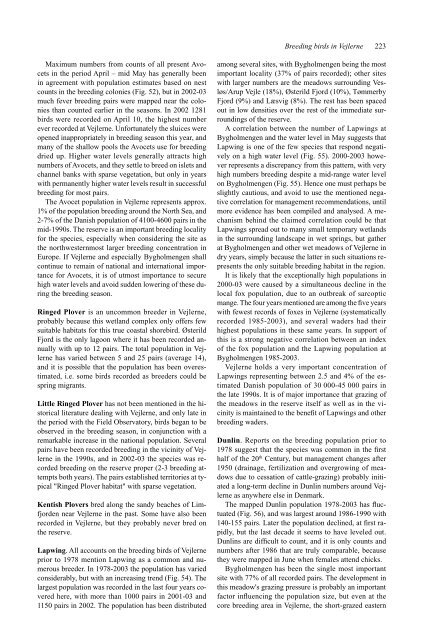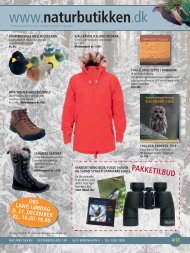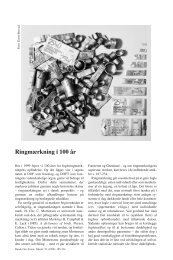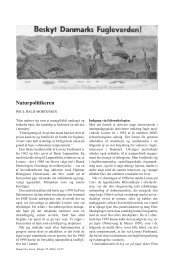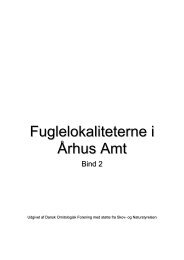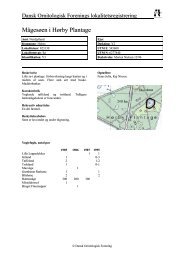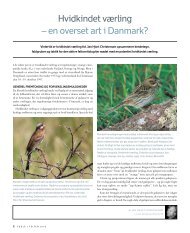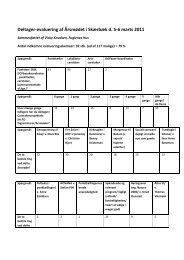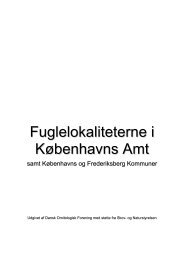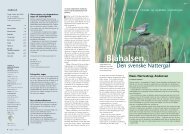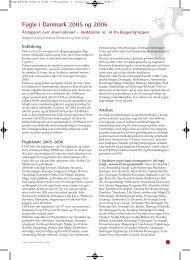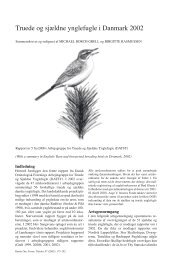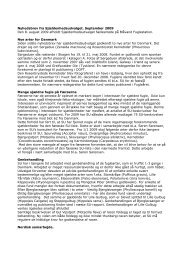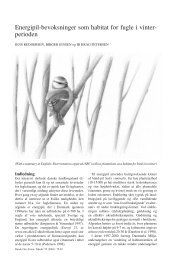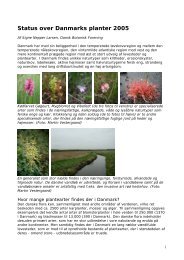Ynglefugle i Vejlerne - Dansk Ornitologisk Forening
Ynglefugle i Vejlerne - Dansk Ornitologisk Forening
Ynglefugle i Vejlerne - Dansk Ornitologisk Forening
You also want an ePaper? Increase the reach of your titles
YUMPU automatically turns print PDFs into web optimized ePapers that Google loves.
Maximum numbers from counts of all present Avocets<br />
in the period April – mid May has generally been<br />
in agreement with population estimates based on nest<br />
counts in the breeding colonies (Fig. 52), but in 2002-03<br />
much fever breeding pairs were mapped near the colonies<br />
than counted earlier in the seasons. In 2002 1281<br />
birds were recorded on April 10, the highest number<br />
ever recorded at <strong>Vejlerne</strong>. Unfortunately the sluices were<br />
opened inappropriately in breeding season this year, and<br />
many of the shallow pools the Avocets use for breeding<br />
dried up. Higher water levels generally attracts high<br />
numbers of Avocets, and they settle to breed on islets and<br />
channel banks with sparse vegetation, but only in years<br />
with permanently higher water levels result in successful<br />
breeding for most pairs.<br />
The Avocet population in <strong>Vejlerne</strong> represents approx.<br />
1% of the population breeding around the North Sea, and<br />
2-7% of the Danish population of 4100-4600 pairs in the<br />
mid-1990s. The reserve is an important breeding locality<br />
for the species, especially when considering the site as<br />
the northwesternmost larger breeding concentration in<br />
Europe. If <strong>Vejlerne</strong> and especially Bygholmengen shall<br />
continue to remain of national and international importance<br />
for Avocets, it is of utmost importance to secure<br />
high water levels and avoid sudden lowering of these during<br />
the breeding season.<br />
Ringed Plover is an uncommon breeder in <strong>Vejlerne</strong>,<br />
probably because this wetland complex only offers few<br />
suitable habitats for this true coastal shorebird. Østerild<br />
Fjord is the only lagoon where it has been recorded annually<br />
with up to 12 pairs. The total population in <strong>Vejlerne</strong><br />
has varied between 5 and 25 pairs (average 14),<br />
and it is possible that the population has been overestimated,<br />
i.e. some birds recorded as breeders could be<br />
spring migrants.<br />
Little Ringed Plover has not been mentioned in the historical<br />
literature dealing with <strong>Vejlerne</strong>, and only late in<br />
the period with the Field Observatory, birds began to be<br />
observed in the breeding season, in conjunction with a<br />
remarkable increase in the national population. Several<br />
pairs have been recorded breeding in the vicinity of <strong>Vejlerne</strong><br />
in the 1990s, and in 2002-03 the species was recorded<br />
breeding on the reserve proper (2-3 breeding attempts<br />
both years). The pairs established territories at typical<br />
"Ringed Plover habitat" with sparse vegetation.<br />
Kentish Plovers bred along the sandy beaches of Limfjorden<br />
near <strong>Vejlerne</strong> in the past. Some have also been<br />
recorded in <strong>Vejlerne</strong>, but they probably never bred on<br />
the reserve.<br />
Lapwing. All accounts on the breeding birds of <strong>Vejlerne</strong><br />
prior to 1978 mention Lapwing as a common and numerous<br />
breeder. In 1978-2003 the population has varied<br />
considerably, but with an increasing trend (Fig. 54). The<br />
largest population was recorded in the last four years covered<br />
here, with more than 1000 pairs in 2001-03 and<br />
1150 pairs in 2002. The population has been distributed<br />
Breeding birds in <strong>Vejlerne</strong> 223<br />
among several sites, with Bygholmengen being the most<br />
important locality (37% of pairs recorded); other sites<br />
with larger numbers are the meadows surrounding Vesløs/Arup<br />
Vejle (18%), Østerild Fjord (10%), Tømmerby<br />
Fjord (9%) and Læsvig (8%). The rest has been spaced<br />
out in low densities over the rest of the immediate surroundings<br />
of the reserve.<br />
A correlation between the number of Lapwings at<br />
Bygholmengen and the water level in May suggests that<br />
Lapwing is one of the few species that respond negatively<br />
on a high water level (Fig. 55). 2000-2003 however<br />
represents a discrepancy from this pattern, with very<br />
high numbers breeding despite a mid-range water level<br />
on Bygholmengen (Fig. 55). Hence one must perhaps be<br />
slightly cautious, and avoid to use the mentioned negative<br />
correlation for management recommendations, until<br />
more evidence has been compiled and analysed. A mechanism<br />
behind the claimed correlation could be that<br />
Lapwings spread out to many small temporary wetlands<br />
in the surrounding landscape in wet springs, but gather<br />
at Bygholmengen and other wet meadows of <strong>Vejlerne</strong> in<br />
dry years, simply because the latter in such situations represents<br />
the only suitable breeding habitat in the region.<br />
It is likely that the exceptionally high populations in<br />
2000-03 were caused by a simultaneous decline in the<br />
lo cal fox population, due to an outbreak of sarcoptic<br />
mange. The four years mentioned are among the ve years<br />
with fewest records of foxes in <strong>Vejlerne</strong> (systematically<br />
recorded 1985-2003), and several waders had their<br />
highest populations in these same years. In support of<br />
this is a strong negative correlation between an index<br />
of the fox population and the Lapwing population at<br />
Bygholmengen 1985-2003.<br />
<strong>Vejlerne</strong> holds a very important concentration of<br />
Lapwings representing between 2.5 and 4% of the estimated<br />
Danish population of 30.000-45.000 pairs in<br />
the late 1990s. It is of major importance that grazing of<br />
the meadows in the reserve itself as well as in the vicinity<br />
is maintained to the benet of Lapwings and other<br />
breeding waders.<br />
Dunlin. Reports on the breeding population prior to<br />
1978 suggest that the species was common in the rst<br />
half of the 20 th Century, but management changes after<br />
1950 (drainage, fertilization and overgrowing of meadows<br />
due to cessation of cattle-grazing) probably initiated<br />
a long-term decline in Dunlin numbers around <strong>Vejlerne</strong><br />
as anywhere else in Denmark.<br />
The mapped Dunlin population 1978-2003 has uctuated<br />
(Fig. 56), and was largest around 1986-1990 with<br />
140-155 pairs. Later the population declined, at rst rapidly,<br />
but the last decade it seems to have leveled out.<br />
Dunlins are difcult to count, and it is only counts and<br />
numbers after 1986 that are truly comparable, because<br />
they were mapped in June when females attend chicks.<br />
Bygholmengen has been the single most important<br />
site with 77% of all recorded pairs. The development in<br />
this meadow's grazing pressure is probably an important<br />
factor inuencing the population size, but even at the<br />
core breeding area in <strong>Vejlerne</strong>, the short-grazed eastern


